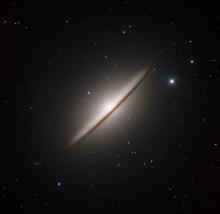Listen to today's episode of StarDate on the web the same day it airs in high-quality streaming audio without any extra ads or announcements. Choose a $8 one-month pass, or listen every day for a year for just $30.
You are here
Making a Giant
M87 is a beast. The galaxy is bigger than our home galaxy, the Milky Way. It contains many more stars than the Milky Way — trillions in all — and has a total mass up to a couple of hundred times the Milky Way’s. And the black hole in its center may be a thousand times the mass of the Milky Way’s.
One thing that M87 doesn’t have is good looks. Instead of a beautiful spiral, it’s an elliptical galaxy. It looks like a fat yellow rugby ball, with a bright middle surrounded by a hazy puffball of stars. Astronomers aren’t sure how M87 got that shape, but they’re working on it.
Unlike spiral galaxies, where the stars all move in an orderly fashion, the stars in ellipticals move pretty much randomly. The stars’ orbits are stretched out. And ellipticals contain little gas for making more stars.
That may mean the galaxies formed from the mergers or two or more giant spirals. A merger could stir up the stars in the original galaxies, and trigger a huge outburst of star formation as clouds of gas ram together. The remaining gas would then be blown out of the galaxy.
On the other hand, ellipticals could have formed from the collapse of massive clouds of gas. That would give birth to many stars, which then blow away the remaining gas — creating plain but “beastly” galaxies.
M87 is well up in the east-southeast at nightfall, in the middle of a triangle formed by the bright stars Denebola, Arcturus, and Spica.
Script by Damond Benningfield






